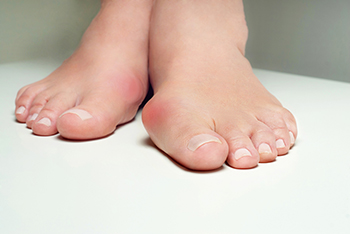3320 North Buffalo Drive
Suite 107
Las Vegas, NV 89129

A bunion is recognized as a hard bump that forms on the outside of the big toe. It develops as a bony protrusion, and it is considered to be a deformity. Genetics may contribute to getting a bunion, in addition to wearing shoes that do not have adequate room for the toes to move freely. This may be a reason why bunions are more common among women, and relief may be found when appropriate-size shoes are worn. A bunion can put pressure on the other toes and may cause them to shift towards each other. Additionally, a corn or callus may form on top of the bunion, which may happen from the toes touching the top of the shoe. Other symptoms may consist of joint pain, and the toes may have a limited range of motion. A bunion may stop growing when larger shoes are worn, and temporary relief may be found when protective pads are worn over it. If you have developed a bunion, it is strongly urged that you consult with a podiatrist who can offer correct treatment options, which may include surgery for permanent removal.
If you are suffering from bunion pain, contact one of our podiatrists of Summerlin Foot & Ankle. Our doctors can provide the care you need to keep you pain-free and on your feet.
What Is a Bunion?
Bunions are painful bony bumps that usually develop on the inside of the foot at the joint of the big toe. As the deformity increases over time, it may become painful to walk and wear shoes. Women are more likely to exacerbate existing bunions since they often wear tight, narrow shoes that shift their toes together. Bunion pain can be relieved by wearing wider shoes with enough room for the toes.
Causes
Symptoms
In order to diagnose your bunion, your podiatrist may ask about your medical history, symptoms, and general health. Your doctor might also order an x-ray to take a closer look at your feet. Nonsurgical treatment options include orthotics, padding, icing, changes in footwear, and medication. If nonsurgical treatments don’t alleviate your bunion pain, surgery may be necessary.
If you have any questions, please feel free to contact our office located in Las Vegas, NV . We offer the newest diagnostic and treatment technologies for all your foot care needs.